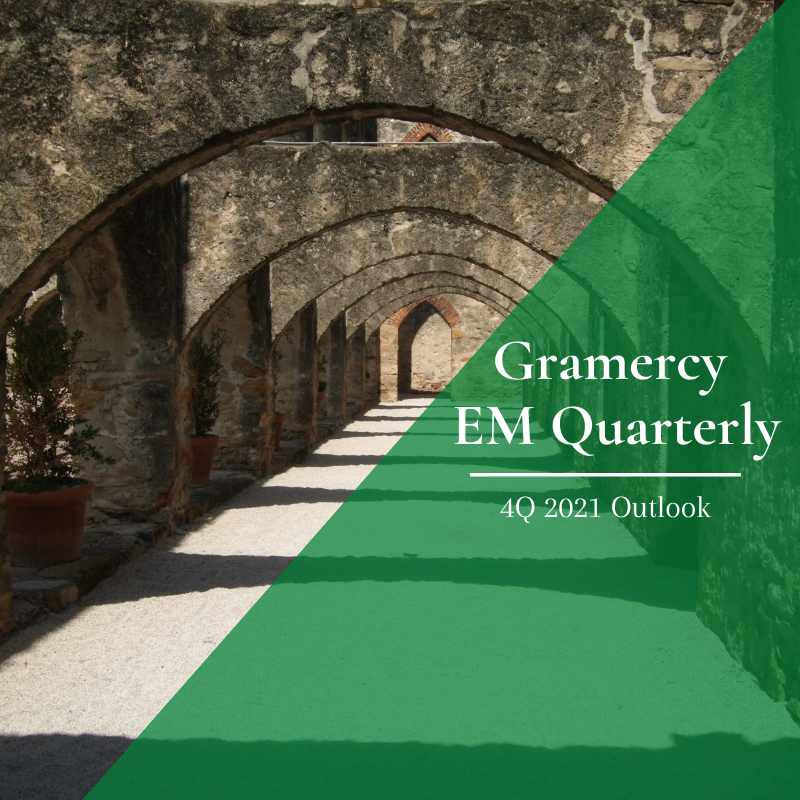Authored by:
Robert Koenigsberger, Managing Partner & Chief Investment Officer
Mohamed A. El-Erian, Chair
Petar Atanasov, Senior Vice President & Co-Head of Sovereign Research
Kathryn Exum, Senior Vice President & Co-Head of Sovereign Research
September 30, 2021
Decoding the Global Macro Environment: A Top-down Perspective and the Related Implications for Emerging Markets Heading into 4Q 2021
As we come to the end of the year, a notably differentiated global economy faces common challenges whose implications vary enormously at the individual country level. Three of these – the continuing battle against COVID-19, relatively high and more persistent inflation, and an impending monetary policy pivot at the Federal Reserve – are of particular relevance to developing economies and emerging market investors.
Proving more infectious than previous mutations of the COVID-19 virus, the Delta variant took some of the steam out of what was a promising global economic recovery overall. As negative data surprises started to outnumber positive upsides, a growing number of analysts revised down their 2021 growth projections for China and the United States, the two locomotives of the current economic recovery. Growth expectations for several other countries have also been lowered.
Having said that, the global economic outlook, while somewhat weaker from before, is far from unsatisfactory. 2021 will still see a robust bounce back. What remains worrisome, however, is its composition.
Developing country growth is likely to be slower than that of advanced economies, pausing the multi-decade gradual convergence process and, even worse, risking that some of the low-income countries fall off the convergence process altogether. This will accentuate the existing dispersion in individual country performance, a theme that we previewed in our 2021 look ahead.
The dispersion is likely to persist, if not grow, as the Delta variant exposes the notable extent to which countries vary in their ability to control infections, broaden vaccination, limit the emergence of new variants, and compensate for the new economic and financial headwinds.
As illustrated by the impact of the closure of ports in China and Vietnam, the Delta variant has also accentuated the supply side problems that have dogged the global economy more in recent months. From supply chain disruptions and high transportation costs to worker shortages and a record level of job vacancies in an increasing number of advanced economies, these disruptions are being caused by more than just rapidly-reversible drivers.
Longer-term structural factors are also in play and are likely to result in inflation that is higher and more persistent than currently priced by markets. With that, central banks’ commitment to exceptionally and persistently loose monetary policy may be harder to justify and maintain, especially for the Federal Reserve.
All this suggests a more differentiated economic and financial landscape that markets may find harder to ignore because of confidence in continuously ample and predictable central bank liquidity injections. Indeed, central bank policy around the world is tightening, led by central banks in developing countries eager to contain mounting inflationary pressures.
The more such a world plays out, the greater the need for investors to differentiate between and within segments of emerging markets, the greater the importance of granular analyses, and the less favorable the expected risk-reward from just surfing the global liquidity wave. Name selection and smart structuring are likely to dominate passive investing. Conviction will be needed to navigate the higher market volatility that is likely to accompany greater global economic dispersion in a world less swamped by central bank liquidity.
Themes Influencing Investment Decisions in 4Q 2021
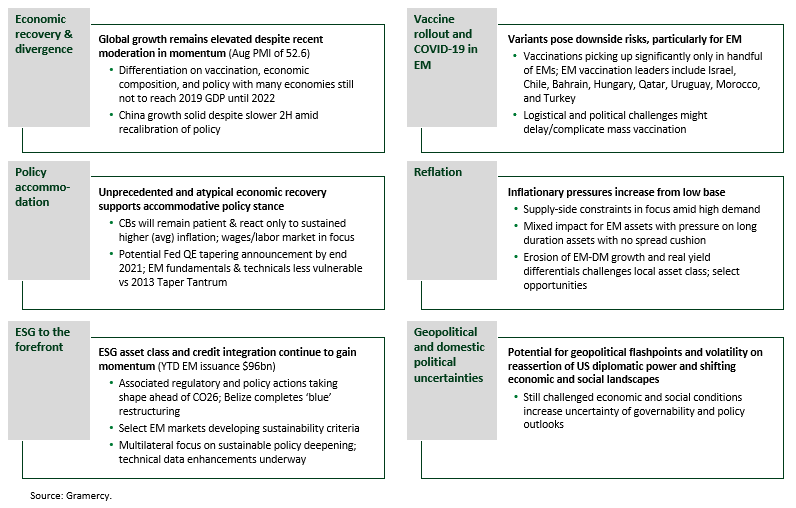
Solid global growth to be upheld despite recent moderation on the Delta variant and supply constraints
The world economy should continue to expand at a robust rate in the last quarter of the year despite some softening in recent high frequency data. While Chinese PMIs shifted into contraction in August, strength within the developed market as well as select EM economies endured, keeping global composite PMI comfortably in expansionary territory (3Q average of 55pts). Growth divergence remained prominent as measured by the standard deviation across select major EM and DM economies, averaging 5.9, up from 4.6 the prior quarter. The differential between emerging market and developed market economies remained negative albeit with some modest improvement amid softer momentum in the U.S. toward the end of the quarter.
Going forward, we expect the Delta and other virus variants to continue to have an impact on supply chain dynamics and activity on a country-by-country basis albeit to a lesser extent than previous waves given continued vaccine momentum and adapted behaviors to live with the virus. Recent data in countries that battled earlier bouts of the Delta variant, such as South Africa, India, and others support this view with higher levels of growth sustained than during the worst of the outbreaks and swifter recoveries. Debate over risks of stagflation will likely continue into the end of the year particularly if data softens or U.S. activity is threatened by a temporary government shut down amid management of a budget resolution and the debt ceiling. However, we would envisage the impact and duration of this to be short-lived. We do not see a threat to growth from a base case expectation for a well-telegraphed taper from the Fed in mid-to-late 4Q.
In China, we believe that growth will be capped by more stringent and traditional virus control measures through the fall and winter, keeping data around current levels with variation depending on case trajectory and policy. We expect continued regulatory pressure and rollout aligned with President Xi’s long-term vision and common prosperity goals, which will pose headwinds for select sectors such as property and tech among others.
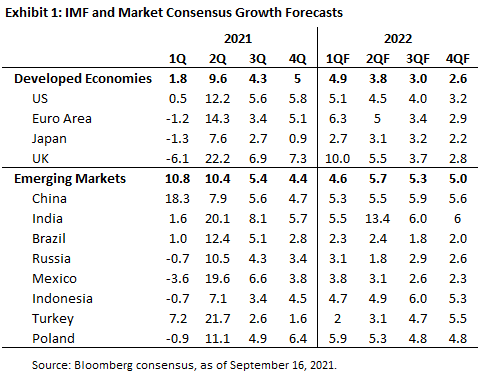
Associated growth pressures should be offset by incremental easing at the macro level, likely through RRR cuts and a modest step up in local government issuance, falling short of a material easing of conditions. While we see prospects for Chinese growth to disappoint relative to market consensus, we do not anticipate a material activity shock. However, we see some room for softness in commodity prices in the fourth quarter but expect levels to remain elevated from otherwise still robust global growth.
Downside risks to this view include a vaccine resistant and more lethal virus variant or policy or market accidents in a major economy such as the U.S. or China as the former embarks on unprecedented monetary policy normalization and the latter delicately balances COVID-19, property tightening, and regulatory expansion without jeopardizing financial stability via moderate targeted support as needed.
Signals on DM inflation outlook are mixed, but well-telegraphed Fed tapering prospects mitigate EM market risks into year-end
Inflation in industrialized economies has been running materially higher this year compared to reference levels from the recent past, partly driven by strong demand as economies re-open and partly due to significant supply side bottlenecks limiting access to goods and services. In addition, tight labor market conditions in many sectors have been putting upward pressure on wages, especially in lower income brackets, creating an even stronger pull-push environment for inflationary pressures. In this context, the main question that market participants and policymakers are asking is “are these developments transitory or structural in nature?”
Looking ahead to the last quarter of 2021, what will matter for markets in general and EM investing in particular is the Fed’s (and the other systemic central banks’) reaction function to inflationary dynamics. Thus far, Fed officials have generally maintained a relatively unified narrative on the side of the “transitory” camp. Importantly, we think that the prospects of tapering of asset purchases are well-telegraphed to markets, limiting the potential disruption for EM assets unless there is a major deviation from the base case that envisions a December 2021 start of a gradual tapering process. This being said, the Fed’s approach will likely remain highly data dependent, opening up the possibility for departure from the consensus scenario depending on the U.S. economy’s trajectory and how the pandemic evolves in the coming months.
Meanwhile, some market participants believe that by having delayed tapering as much as possible, the Fed has made a serious policy mistake that could potentially undermine its ability to control inflation going forward. As such, the Fed might find itself in a situation in the not so distant future when it is forced to “hit the brakes” (i.e. raise interest rates) while still “taking its foot off the accelerator” (i.e. tapering asset purchases), with significant negative market implications. At the start of 4Q, the signals on the inflation outlook are mixed, at best. On one hand, elevated producer price indices (PPI), especially in the U.S., suggest that there might be further upside “in the inflation pipeline” of the developed world (Exhibit 2), which could challenge the still predominantly dovish bias of the systemic central banks. On the other hand, emerging signs of softening supply chain constraints, which are key for the inflation outlook, appear to continue to move in that direction and the underlying details from recent inflation prints in some major economies seem to indicate fading inflationary pressures.
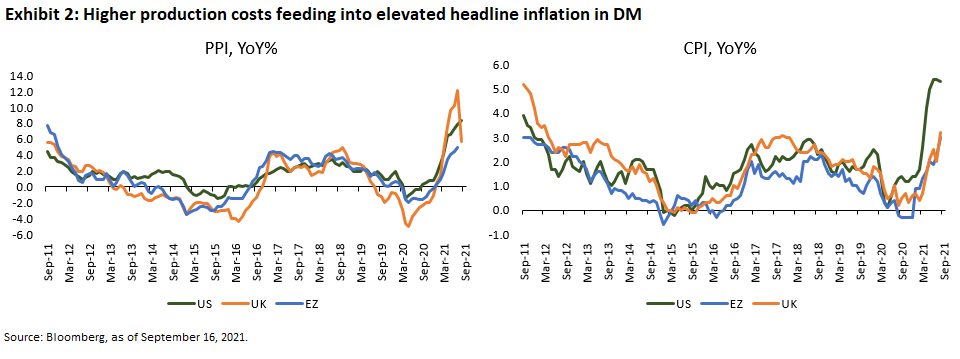
Looking ahead, as the highly accommodative global economic policy backdrop that markets are so accustomed to starts to turn incrementally less supportive, we believe that EM as an asset class is in a less vulnerable position today relative to the so-called taper tantrum of 2013. Although debt burdens for global sovereigns have increased materially in the last several years, especially during the COVID-19 crisis response, other key credit and technical metrics for EM are in a much better shape. For example, inflation dynamics and external balances in EM are materially healthier compared to 2013. In addition, credit bubbles do not seem to be a wide-spread/systemic problem at present, while EM is also enjoying a considerably more benign technical picture. As such, looking forward to 4Q, we continue to expect fundamentals-driven performance dispersion among sovereign and corporate credits, but no major outflows from EM asset classes.
COP26 and ESG-related policies to set stage for medium-term outlook
While the backdrop and momentum for global coordination on climate policy remains complex and challenging, we anticipate countries to announce and debate new more aggressive 2030 NDCs (nationally determined contributions), agendas, and policies that will shape the investment landscape for years to come ahead of the UN Climate Change Conference of the Parties (COP26) in Glasgow in the first half of November. Relatedly, the EU’s Fit for 55 legislation released over the summer now calls for a 55% reduction in emissions by 2030 vs. 1990 levels, up from 40%. It increases the scope for impacted industries to buildings, maritime and aviation and includes a carbon border adjustment mechanism. Key topics and measures such as carbon border taxes, raw materials legislation, and reshoring of supply chains will likely have material market implications for certain sectors, regions, and countries.
We expect continued development and clarity on country specific lending practices and ESG criteria guidance in the coming quarter as well as sustained ESG financing momentum with YTD issuance of $96bn, well above the record 2020 aggregate level of $45bn. While the bulk of funding is at the corporate level, we anticipate that additional debut GSS (green, social, and sustainability) sovereign issuers come to the market as well as gradual development of local GSS markets. Lastly, we also anticipate the fall World Bank IMF Meetings in early October will encompass ESG oriented policy discussions and provide insight on progress on sovereign-level data collection.
Geopolitical and domestic political events to watch in 4Q
With the Biden Administration’s review on U.S.-China policy nearing its finish, we expect details to emerge on trade and technology sector measures this quarter. On the former, we think there is scope for eventual tariff recalibration possibly baked into a new investigation of industrial subsidies, which would afford the government the ability to provide some relief on consumer oriented goods but maintain a tough stance, keeping most existing tariffs in place with the prospect for additional ones. The G20, APEC, and COP meetings in late October and early November are key dates for headlines and clarity on this topic.
In Latin America, we continue to expect domestic politics to trump geopolitical developments in the near-term as the region faces the political repercussions of the pandemic as outlined in our last quarterly report. The Argentine primary mid-term vote held in September delivered a blow to the ruling Frente de Todos (FDT) party and markets will be tuned into the November 14th vote to see if the government loses its majority in Senate as well as the race in the Province of Buenos Aires. While policymaking will remain challenged in the aftermath of the FDT defeat, prospects for improvement on the back of opposition strength heading into the 2023 Presidential Election combined with an IMF deal should be a boon for Argentine assets over the medium-term. On the geopolitical front, the U.S. will likely remain supportive of Argentina’s IMF negotiations. Speaking of IMF and U.S. support, we think both will remain very strong for Ecuador’s reformist cabinet under liberal president Guillermo Lasso as it navigates a complex domestic political environment. On Venezuela, the Biden Administration’s strategy appears to be constrained by domestic political considerations ahead of the 2022 mid-term elections, especially in regards to recent poor performances by the Democratic Party in Florida, a key battleground state. However, ongoing talks between the Maduro regime and Venezuelan opposition could produce an opening for some quid-pro-quo in the form of modest sanctions relief in exchange for a roadmap toward “free and fair” elections in 2022-23 that could unlock Venezuela’s longstanding political deadlock. Elsewhere in the region, in November Chile is headed toward critical elections that will determine the direction of economic policy and drive asset performance (as well as Brazil and Colombia in 2022).
Uncertainty on an Iran nuclear deal in 2021 has increased following a slow start to talks in the backdrop of the election of hardliner Ebrahim Raisi in June. However, a deal still remains possible in the latter half of the quarter if steady talks resume and Abbas Araqchi remains as head negotiator. Any potential sanctions rollback would be incremental, coordinated with OPEC and largely a 2022 story at this juncture.
Optimal Asset Allocation within EM in this context
Despite concerns of Fed tapering, the Delta variant and supply shocks, thus far it has been a good year for risk assets. However, with the robust economic growth, there continues to be uneven participation and dispersion in individual country performances. Furthermore, with the challenges of COVID-19 have come escalating political polarization, even in countries that have been well rated going into the crisis. Two examples include Chile and Peru where the impact of COVID-19 has resulted in previous stable political regimes being put at risk. The fact that these “low beta anchor credits” are under pressure challenges the very notion of convergence trades. We may see what happens when the anchors blow wider than the credits that were converging in that direction.
Inflation and higher commodity prices are persisting in EM once again, despite previous notions that EM is a homogenous asset class, resulting in winners and losers to this theme. Not all EMs are energy and commodity exporters. This dispersion will drive markedly different outcomes for each set.
Given these combined factors, we believe that investors must focus on absolute value rather than relative value. In depth analysis is necessary to secure high conviction capital deployment. There simply is no room for lazy longs being used to soak-up unused capital, capital that can disappear when the liquidity tide goes out. We remain mindful of illiquidity/dislocation bouts, both defensively and offensively. Doing so commands that investors overlay hedges where appropriate and expect and embrace volatility on good names that are unduly effected. This requires underwriting of credits before the next dislocation as recoveries have been and are expected to be swift on quality names.
Today, more than ever, there is a tension in the market place between “fully invested bears” and the desire to preserve existing returns and capital.
For us in EM, that means looking for high conviction, intelligent ways to participate in the market yet simultaneously build ROA (resilience, optionality and agility). EM continues to provide an opportunity to achieve these dual objectives via a multi-asset, dynamic, bar-belled approach (See Exhibit 3).
On one side of the barbell, we are combining high quality emerging markets debt names (on an interest rate hedged basis) with well collateralized, structured, private credit.
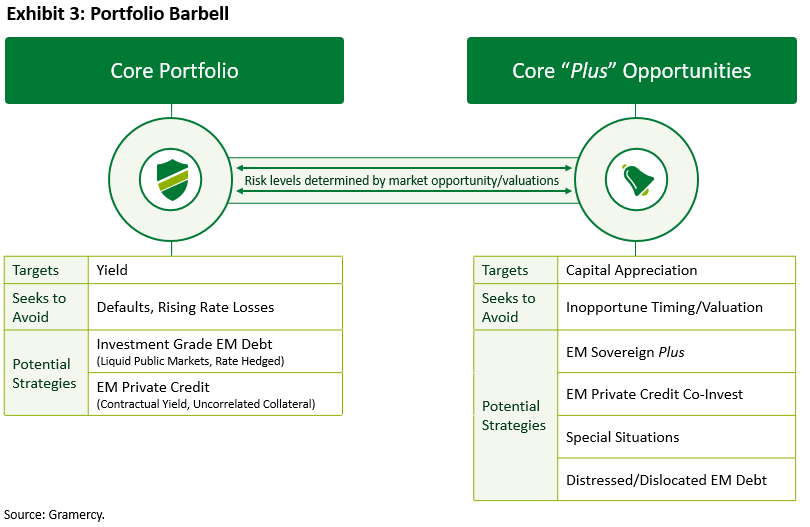
Private credit in EM allows one to pick-up substantial yield, and security as well as explicit compensation for illiquidity. Too many EM investors park in “liquid” instruments when they don’t really need the liquidity. The opportunity cost of doing so is quite high.
The other side of the barbell is anchored in opportunistic and dislocated credit and special situations (as they present themselves). These opportunities may arise on both a systemic basis (March 2020) or idiosyncratic basis (Turkey 2018). Perhaps we are entering such a dislocation for Chinese credits.
One of the biggest challenges in EM today (and other credit markets) is the potential for dislocation risk. EM corporate debt outstanding is 5x larger today than it was in 2010. Yet due to fewer banks and smaller market-making operations at those banks, there is insufficient liquidity when investors look to exit the market. This is exacerbated by the fact that so much of that risk is embedded in ETFs, UCITS and other “liquid” vehicles. Just because the vehicle is supposedly liquid does not ensure liquidity for the underlying portfolio. When there are outflows from EM debt, they will create volatility/dislocations as there will prove to be pockets of illiquidity amongst all of the “liquidity” that is in the markets today. This poses both a risk to be hedged today and an opportunity to be underwritten for tomorrow.
Emerging Markets Debt
EM debt continued to post positive returns in 3Q in the context of a carry environment supported by benign U.S. Treasury moves. The only exception to this remains local debt which continues to be volatile and generally under pressure, albeit moderately so. EM debt returns in July and September were dampened by poor performance in Asia on the back of regulatory headlines and idiosyncratic events in certain industries (e.g. Chinese real estate, Macau gaming) and YTD dispersion of returns remains high within the universe. Overall, YTD high yield is outperforming investment grade and corporates are outperforming sovereigns (hard and local currency) See Exhibit 4.
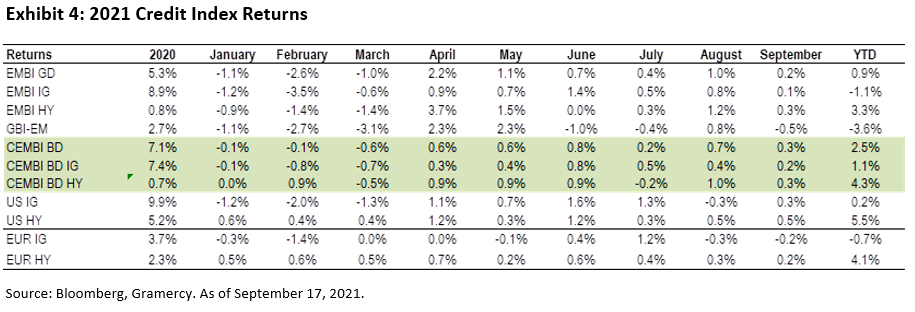
Strong EM debt returns continue to be anchored by solid fundamentals, attractive relative valuations vs developed markets and strong technicals.
• We believe EMs have a robust medium-term growth outlook vs developed markets – despite COVID-19 and its variants, EM’s traditional growth premium over DM is projected to increase sharply over the medium-term, supporting financial inflows and fiscal consolidation efforts in EM economies. Current accounts have adjusted across the board and tend to be in surplus for many EM economies. Compared to the time of the “Taper Tantrum”, inflation dynamics are under control in most major EM economies, while external imbalances / weakness have eased, and, in some cases, completely reversed; this allows EM central banks more flexibility in terms of using monetary policy to support economic growth and absorb external shocks.
• EM corporate fundamentals overall proved to be resilient in 2020 with only a slight increase in net leverage of 0.2x and 0.3x for EM corporate IG and HY, respectively. EM IG corporate net leverage remains about a turn lower than for U.S. credits while the HY differential has widened materially to 1.7x as EM HY corporate kept more cash on their balance sheets to shield themselves from macro headwinds.
• EM corporate credit metrics should continue to improve beyond pre-pandemic levels on the back of strong economic recoveries and relatively high commodity prices on a historic basis (even if moderating from the highs).
• Valuations in HY still look compelling with spreads still about 111bps from the 2018 tights for corporates and 188bps for sovereigns, respectively. EM corporate IG and HY also provide additional spread of 58bps and 88bps relative to U.S. IG and HY, respectively.
• Flows should remain strong – EM hard currency inflows were $12.6bn in 2020 ($40bn of inflows from March onward after outflows of $27bn in March). 2021 has continued in strong fashion with $18.6n in inflows already.
4Q will be an important quarter for Fed policy and markets generally. While weaker than expected jobs data in the U.S. in August may delay prospects of tapering post the September FOMC meeting, continued hawkish comments from FOMC members on the back of other positive economic data prints lead us to believe that tapering is still likely to occur in 2021. Amidst mixed economic data, however, we believe that the Fed is likely to be cautious such that tapering will more likely than not be executed in a more orderly fashion. In this environment, we believe that EMD, particularly shorter duration return streams with a healthy spread buffer, should continue to perform well. This means we still prefer EM corporates over sovereigns, high yield over investment grade and hard currency over local currency.
Alternative Credit
Our dynamic credit strategy seeks high, consistent returns throughout the credit cycle using a rotational approach to EM credit, which we believe can be achieved by deploying bottom-up security selection within cyclically favorable credit sectors. As our top down view in 3Q21 indicated, we are transitioning from a “Late Stage Recovery” to an “Extended Valuations” paradigm. Our strategy target weights are roughly: 30% performing dedicated high yield, 30% performing opportunistic high yield, 20% sovereign+, and 20% distressed.
At the end of the second quarter, the strategy was approximately 87% invested and was skewed to performing dedicated high yield (40%) and performing opportunistic high yield (24%) as we continued to 1) build our sovereign+ allocation; and 2) patiently wait for asymmetric distressed opportunities. We believe our allocations to performing dedicated high yield and performing opportunistic high yield offer attractive carry (at the end of June the YTM of the combined Performing strategies was 7%) as we build our allocations to sovereign+ and distressed.
While we continue to believe the fundamental backdrop suggests there should be more corporate and sovereign distress, the abundant liquidity in the system has created an environment of limited distress thus far in 2021 (JPM places the YTD 2021 EM corporate default rate at just 1.2%, well below their 2021 forecast of 2.5%). Our distressed allocation stands at approximately 9.2% as we near the end of September 2021 and is most heavily weighted to Sri Lanka (sovereign), Argentina (sovereign), and Ecuador (sovereign). Argentina bond prices rallied for much of 3Q21, led by a better-than-expected performance from the opposition in the September PASO as well as signaling on an IMF agreement (2022 budget assumption). Political infighting and associated cabinet changes in the aftermath of the PASO erased most of the gains.
We believe that there continues to be a compelling asymmetry: a left-tail event which assumes another restructuring in 2024 is largely priced-in while a right-tail event such as a new IMF agreement could generate meaningful returns over the next two years. In the corporate distress area, we added a small position to Evergrande, China’s largest property developer by land bank. With bond prices in the 30s, we believe that there is a compelling risk/reward given substantial non-core assets at the issuing entity level as well as the essential nature of the enterprise. We also saw positive attribution from our position in CLISA, an Argentine industrial name which completed its consensual distressed exchange in 3Q21 and is now secured with a collateral package.
What to Watch
• Evergrande – A liquidity scare in 2020 has mushroomed into a de facto default by China’s most indebted real estate developer. The company has engaged advisors and entered a 30-day interest grace period ahead of a more comprehensive restructuring that will test Beijing’s willingness to bail out yet another systemically important company and sector.
• Airlines – A broad array of distressed claims being marketed ahead of DIP to equity conversions expected over next couple of months.
• Province of Buenos Aires – Restructuring completed with 98% acceptance. Terms commensurate with sovereign restructuring from a year earlier: no principal haircut, coupon reduction and maturity extension; however, PBA offers 200bp pickup in YTM and 500bp pickup in current yield.
• Argentina – Opposition candidates did better than forecast in primary elections in September, signaling a likely shift away from Kirchnerism as Argentina looks to conclude a deal with both IMF and Paris club.
• Lebanon – Government formed but governability still a question mark. Restructuring debt with no new sources of capital and limited GDP scope make bond prices in teens still unappealing.
• Venezuela – Latest round of Norway talks concluded in Mexico City. Broad participation from opposition upcoming elections. OFAC recently indicated that it would review restrictions on foreign debt in 1H22 as the National Assembly’s mandate ends in January 2022.
• Dislocated commodity producers – Major players who flirted with bankruptcy during the COVID-induced fall in global oil and commodity prices have largely repaired their balance sheets. Despite an expected recovery in cash flow generation, several players still trade at dislocated/distressed levels.
• Global NPLs – As COVID-19-support for bank, non-bank and corporates start to fade in the emerging world, expect to see a pick-up in NPL rates. Opportunities to acquire NPLs or finance acquisition of NPL portfolios should start to materialize in 1H22.
• Distressed/dislocated equities – Several companies, particularly in the commodities sectors, have not fully priced in the sharp rebound in commodity prices. We see opportunities to consolidate material stakes and drive change through corporate finance initiatives.
Capital Solutions
Throughout the summer, the Capital Solutions (Private Credit) strategy continued to generate a robust pipeline in particular in markets such as Turkey, Mexico, Colombia and Peru. Part of the sourcing comes from our strong internal capabilities, but we are also seeing increased flow from our financial institution partners throughout our global universe. Travel has continued to open and we recently completed trips to Turkey, Mexico, Europe, and Ukraine. Although global EM growth is not uniform due to COVID-19 particularities, we continue to see a private credit market whereby robust structures and collateral underpin compelling return opportunities. On the ESG front, our updated “ESG 2.0 approach” has been well received by borrowers and has allowed us to have a positive impact on these companies by incorporating improvements to their ESG policies and procedures through our loan structures. On the political side, Argentina held a recent midterm primary that indicated that the left leaning ruling party may lose congressional seats in the midterm elections. Although this doesn’t yet change our view on the sovereign, it does provide greater optionality to a positive change to the government in 2023.
Special Situations
The Special Situations strategy has continued to foster its pipeline of investments while also closing on several key transactions during 3Q. The group employs a barbell investment philosophy, both from a duration and risk/return perspective.
Opportunities consist primarily of litigation funding arrangements collateralized by future receivables with an investment duration that ranges from 12 to 36 months. In addition, the strategy seeks to insure its principal investment against default in order to protect investor capital. The Special Situations team has leveraged its law-firm network to expand its pipeline of investments and generate new, organic investment opportunities.
The group’s long-duration strategy consists primarily of international arbitration claims where investment duration can range from 3-7 years. In certain instances, the strategy will seek to insure a portion, or the entirety, or its arbitration funding costs against adverse litigation outcomes.
Special Situations is in the final stages of closing on an international arbitration claim against a Latin American country. Looking forward, the team has a pipeline of international arbitration claims to underwrite and is closely monitoring the energy sector in Mexico as well as economic and political developments in Argentina and Peru which may yield new opportunities in the future.
In conclusion, despite certain risks and uneven initial conditions, thus far 2021 has proven to be a strong period for both economic and financial market performance in certain EM markets and assets. We have actively participated in both public and private EM credit markets as well as in special situations. However, given what could prove to be late cycle, stretched valuations, we will invest consistent with the global top-down themes that we have identified. We will be keen to differentiate between winners and losers and dynamically allocate assets as absolute and relative value changes. This will entail constant triage of both top-down and bottom-up factors that will inform our dynamic asset position/allocation, planning the trade/trading the plan and agile hedging to ensure resilience, optionality and agility.
About Gramercy
Gramercy is a dedicated emerging markets investment manager based in Greenwich, Connecticut with offices in London, Buenos Aires and Mexico City, and dedicated lending platforms in Mexico, Turkey, Peru, Pan-Africa, Brazil, and Colombia. The firm, founded in 1998, seeks to provide investors with attractive risk-adjusted returns through a comprehensive approach to emerging markets supported by a transparent and robust institutional platform. Gramercy offers alternative and long-only strategies across emerging markets asset classes including multi-asset, private credit, public credit, and special situations. Gramercy is a Registered Investment Adviser with the SEC and a Signatory of the Principles for Responsible Investment (PRI). Gramercy Ltd, an affiliate, is registered with the FCA.
Contact Information:
Gramercy Funds Management LLC
20 Dayton Ave
Greenwich, CT 06830
Phone: +1 203 552 1900
www.gramercy.com
Joe Griffin
Managing Director, Business Development
+1 203 552 1927
[email protected]
Investor Relations
[email protected]
This document is for informational purposes only, is not intended for public use or distribution and is for the sole use of the recipient. It is not intended as an offer or solicitation for the purchase or sale of any financial instruments or any investment interest in any fund or as an official confirmation of any transaction. The information contained herein, including all market prices, data and other information, are not warranted as to completeness or accuracy and are subject to change without notice at the sole and absolute discretion of Gramercy. This material is not intended to provide and should not be relied upon for accounting, tax, legal advice or investment recommendations. Certain statements made in this presentation are forward-looking and are subject to risks and uncertainties. The forward-looking statements made are based on our beliefs, assumptions and expectations of future performance, taking into account information currently available to us. Actual results could differ materially from the forward-looking statements made in this presentation. When we use the words “believe,” “expect,” “anticipate,” “plan,” “will,” “intend” or other similar expressions, we are identifying forward-looking statements. These statements are based on information available to Gramercy as of the date hereof; and Gramercy’s actual results or actions could differ materially from those stated or implied, due to risks and uncertainties associated with its business. Past performance is not necessarily indicative of future results. This presentation is strictly confidential and may not be reproduced or redistributed, in whole or in part, in any form or by any means. © 2021 Gramercy Funds Management LLC. All rights reserved.
